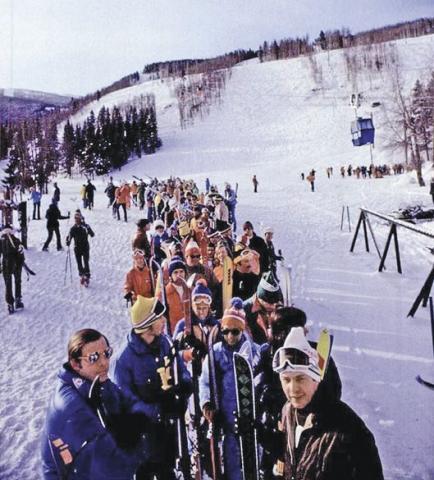
They spent almost an hour in line, yet more and more skiers came, bonding as they waited ... and waited.
Lift lines have been part of the ski experience as long as there have been lifts. Is there such a thing as a line that’s too short?
Beginning after World War II and for the next 40 years, a weekend skier waited in liftline so long that the person next to him had a time to describe where he was born, his best powder day, his favorite music, why he deserved a promotion at the office and … hey, check out those vintage skis over there. Skiers could wait in line for an hour, all for a 12-minute ride up the mountain and the reward of a quick descent.
Snail-paced lift queues—usually exasperating and sometimes bone-freezing—arose from the relentless supply of young baby boomers demanding to ski. Their numbers exceeded the growth of a new ski areas and lifts, even though that growth itself was spectacular. In the 10-year period between 1956 and 1966, more than 580 ski areas with chairlifts and T-bars came into being, many of them previously equipped with ropetows. Yet it wasn’t enough.
The number of U.S. skiers quintupled over the same period. And when a million or more of them arrived at the bottom of the mountain with their kids on a Saturday morning, the place looked like a standing-room only Beatles concert. Waits of 45 minutes and more were common across the country, from Stowe to Boyne to Big Bear.
Some relief arrived with the advent of tripe and quad chairlifts, but the big breakthrough came in the early 1980s with the introduction of the detachable lift. Climbing speeds doubled, and lift-shutdowns from boarding mishaps were sharply reduced. The new chairs and gondolas were line-busters.
In the past five years of the 20th century, North American ski resorts installed 250 high-capacity lifts, collectively capable of carrying more skiers uphill than all of the lifts that existed in the winter of 1965-66 combined.
In the 1950s and 1960s, observed writer Morten Lund, liftlines allowed enough time “to meet a member of the opposite sex, get infatuated, engaged and plan the wedding.”
Today, a Saturday or Sunday liftline scarcely allows time to land an après-ski date. No one wants to regress to slow lifts, but history suggest that long queues once helped develop skiing reputation as an irrepressibly sociable sport. 
Excerpted from the March-April 2008 issue of SKI magazine. John Fry (1930-2020) was editorial director of SKI and Snow Country magazines and longtime president, then chairman, of ISHA. He authored the award-winning book The Story of Modern Skiing. His final book, published posthumously, is Abandon Foolish Scheme: Deathly encounters that you won’t find in bestsellers about dying.
